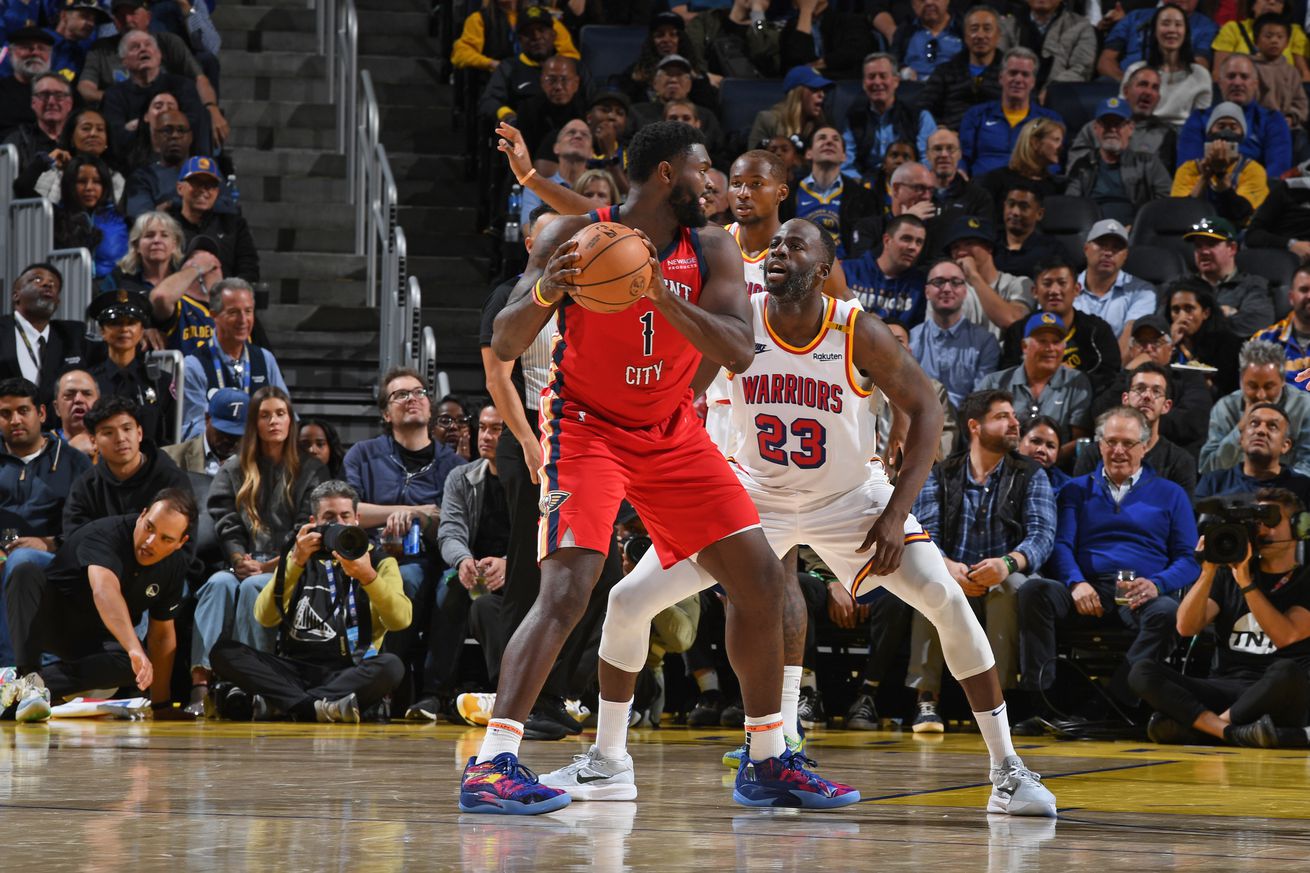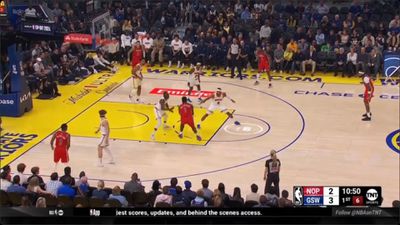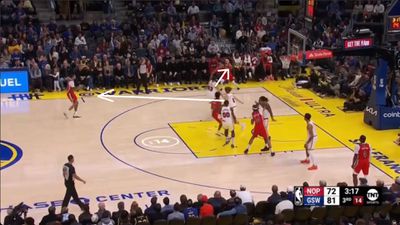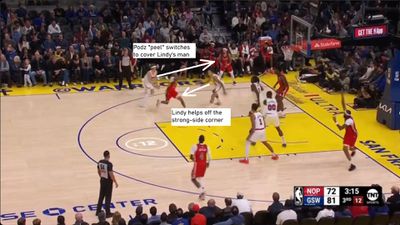
Defense was the name of the game.
Watching the first half — in particular, the first quarter — of the Golden State Warriors’ raucous victory over the New Orleans Pelicans, you wouldn’t think that it ended in a defensive masterpiece, one where the Warriors would limit the Pelicans to 110.4 points per 100 possessions (equivalent to eighth in the league in terms of points allowed per 100 possessions, albeit in a very, very young season mired in small sample size theater). They were also able to hang 129.2 points per 100 possessions on the Pelicans, a gargantuan feat considering they were without Stephen Curry and Andrew Wiggins.
Despite the first quarter — which ended in a 31-14 advantage for the Pelicans — there were possessions peppered within the quarter that provided glimpses and clues behind what the Warriors were about to inflict upon the Pelicans. The recipe for a win was present all throughout; all it needed was to translate into sustainable offense built upon equally sustainable defense. The latter wasn’t just present — it was loud and booming. All it needed was accompaniment by the former.
Take the Warriors’ first defensive possession of the night against the Pelicans, which ended in a successful Brandon Ingram mid-range jumper. It counts as a scoring possession in the stat sheet, but this is where process deserves a closer look despite the result. First possessions provide a lens in terms of teams’ coverage plans, energy level, effort, and other intangibles that can be valuable clues and data.
The possession below is such an example:
Brandin Podziemski and Moses Moody switch assignments on the screening action between CJ McCollum and Brandon Ingram, which is followed by a side ball screen for Ingram by Zion Williamson. Draymond Green steps up higher than typical drop coverage — “up to touch,” or otherwise known as a screen-level step up — which informs the Warriors’ plan on Ingram, which is to not give him breathing room around screens while stopping short of a full two-to-the-ball commitment. A handoff between Ingram and Herb Jones triggers another switch, with Buddy Hield taking Ingram in the post. Hield does an excellent job of not giving Ingram any ground and space. With the shot-clock winding down, Ingram is forced to create something out of nothing — which he does, a testament to his scoring talent.
The data that can be garnered from above: The Warriors being a tad bit aggressive (but not overly so) against Ingram in ball-screen coverage, while switching anyone not named Green or Trayce Jackson-Davis (switching positions 1-3, so to speak). This allowed them to burn the shot clock to the point where the Pelicans had to count on talent to bail them out, which, while valid as a form of offense, isn’t generally sustainable.
Peep at the next defensive possession:
Podziemski’s effort around the screen contributes to the delay of the set. Williamson comes over to set the ball screen, and once again Green steps up a tad higher than typical drop-coverage depth — which means McCollum also warrants slightly more attention than just a mere deep drop.
When the ball is fed to Williamson in the post, watch where Moses Moody positions himself:

In order to wall off the valuable real-estate space that is the middle, Moody helps at the “nail” — the area approximating the middle of the free throw line. Despite Ingram being available one pass away, Moody and the Warriors are comfortable with the fact that should Williamson kick out to Ingram, the trajectory of the pass is long enough for Moody to recover on time. Which is exactly what happens, with Moody getting the strip and the Warriors forcing the 24-second violation.
Of course, the same “nail” help the next time around gives up a rhythm three from Ingram:
But the operative word is “rhythm.” Whenever the Warriors were successful in disrupting the Pelicans’ rhythm regardless of result, they built defensive momentum. They were banking positive defensive possessions in the vault and weren’t fazed by the incredible shot making by Ingram and Williamson.
The important thing was to stick to the program — and supplement it with execution, force, effort, and energy. That program included denying middle penetration as much as possible — or at the very least, crowd the middle with bodies to force a pass out to the perimeter, which is a tough task for the Pelicans considering their lack of bona fide passers and high-level decision makers.
The Warriors’ depth doesn’t just translate on the offensive end — their defense has the luxury of subbing in a certain Gary Payton II, who is fully healthy and seemingly back to his 2022 form. When the Pelicans run Ingram off of an away screen (after Daniel Theis fakes the ball screen up top), Payton sinks back to poke at Ingram at the nail, which helps Jonathan Kuminga recover. Hield also does his part to crowd Ingram’s space, which triggers the pass to Jordan Hawkins. Hawkins’ attempt to attack off the catch is thwarted by Payton again helping at the nail, forcing a jump ball.
The Warriors were fully committed to sending extra bodies toward the Pelicans’ shot makers and were able to live with the result if the process involved dishing a healthy dose of shot difficulty — or managed to get the ball out of their hands.
Another example: Green and Kevon Looney pairing up to make life difficult for Williamson. Again, the Warriors’ mantra against Williamson was to deny him from getting down the middle of the paint, which Green does when he momentarily helps Looney below, before recovering in a timely manner to the cutting Theis. Looney has everything in control — but Williamson turns to his right to create something out of nothing.
It was easy to get discouraged and distraught about such shot-making exploits, but one thing was clear: The Warriors refused to dwell on previous possessions, took each half-court instance as an opportunity to trigger their preferred transition attack, and kept faith. The defensive infrastructure was present — all they needed to do was find a way to translate the stops into points. Perhaps the possession below was what finally convinced them that their efforts weren’t for naught:
Hield stays on Hawkins around the screen (“lock-and-trail”), gets in front, and makes an excellent contest to force the miss — which triggers the break. Hield fills the lane, gets the defender up in the air, and drills the three — one of seven that contributed to his 28 points, 19 of which was scored in the fourth quarter alone.
The Warriors’ faith in their process working led to more and more good process — such as springing bursts of aggression against Ingram, McCollum, and Williamson (i.e., trapping against the sideline vs. the former two and sending extra middle help against the latter):
While switching up coverages against high ball screens by employing a conventional drop setup — allowing Green to be in position to stifle Williamson in the paint:
There’s also the little details peppered in among the larger, more explosive defensive plays. Weak-side defense has been a point of contention for the Warriors for the past couple of seasons, an area which they needed to nail down and clean up. When placed in rotation, it’s paramount that they avoid sending two players at once toward the same player — or risk being burned by a simple swing pass to the adjacent man.
They’ve been remedying past weak-side weaknesses by simply being aware and sharp with their execution of the “X-out” concept (named as such because the close-out maneuvers form an “x”):

Through properly “x-ing out,” weak-side defenders such as Podziemski and Lindy Waters III can properly cover two players simultaneously and shut off open looks in an instant — while also seamlessly executing a strong-side corner help/”peel” switch combination:

This results in perhaps one of the best defensive sequences of the game (in my humble opinion):
The Warriors seem to have something special brewing as a defensive squad. The offense showed up in the most unexpected of ways, yet the irony is that their brand of scoring through stockpiling stops is what was expected of them to start this season. With that said, it’s valid to question the sustainability of a team that places a huge majority of its offensive production on stringing together stop after stop. The element of half-court offense must still be present, especially during mud fights where transition opportunities will be scarce.
That’s where having a healthy Curry and — to a lesser albeit important extent — Andrew Wiggins comes in. Combining a stifling defense and potent offense is a recipe for title contention — a glimpse of which was seen against the Pelicans.